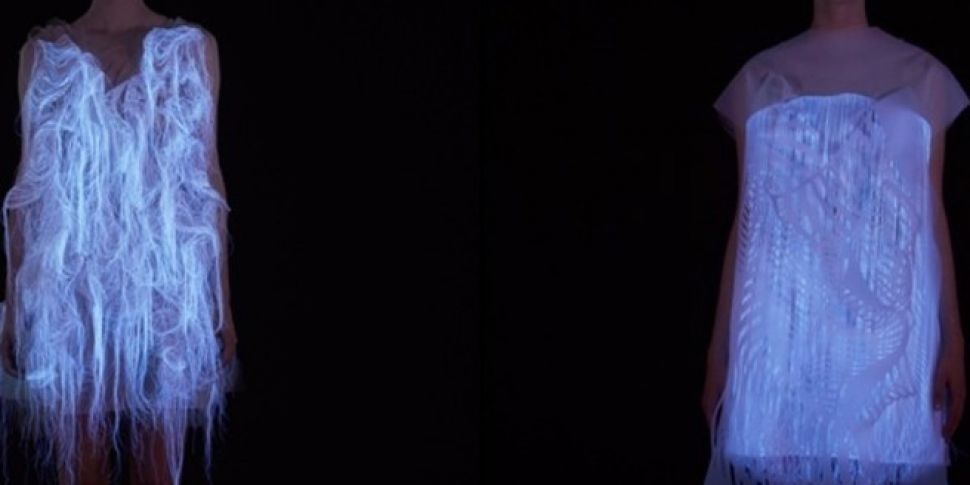The advancement of technology in recent years has inspired fashion designers across the world to create garments that are more than just a piece of clothing.
Merging technology with design has led to innovative uses of sensory fabrics that respond to human touch and sound, material that can potentially combat climate change and stunning patterns inspired by X-ray calibration films.
Science, technology, engineering and maths (STEM), have been at the forefront of some of the most exciting work created by fashion designers in the past decade. With the fashion world's need to always be ahead of the trend, designers are turning to STEM to incorporate futuristic elements in their collections, many of which are made with an important functional purpose in mind.
The following designers are leading the way for the future of fashion, showcasing the importance of design in social situations and our every day lives - offering us a glimpse into what the future holds for the fashion world.
Ying Gao:
A Montreal fashion professor and designer whose designs are based on social interaction was inspired by Paul Virilio’s 1979 essay “Esthétique de la disparition” (The aesthetic of disappearance) to create two organza dresses that are made of photoluminescent thread and an eye tracking technology.
The spectators’ gaze activates the robotics in the dress, giving the outside layering different patterns and contour.
Her 2014 collection “Facebook As A Pop-Up Book”, drew inspiration from the many interactions of social media.
From one “page” of the dress to the other, Ying Gao depicts the social network of five of her Facebook friends. Networks transformed into tree-like patterns, where the size and the depth depend on the number of Facebook friends and the nature of their interactions.

Photo copyright: Dominique Lafonde
Nien Lam and Sue Ngo:
These two New York based programmers/designers created a wearable pollution warning shirt. “Warning Signs” is a visualization of the pollution that exists invisibly all around us.
When the wearable senses carbon monoxide, the piece subtly changes colour from a healthy pink to a slightly worrying grey, to indicate higher levels of carbon monoxide in the atmosphere to the wearer and those around him or her. The piece is designed to provoke conversation with its simple form and subtle reaction to the environment.

Photo credit: Sue Ngo
London-based Cardiac radiographer and designer Brooke Roberts has used digital knitting technology to create garments with patterns based on MRI brain scans and medical imagery.
Brooke meshed images of brain segments captured during medical scans with the drawings of Dutch artist MC Escher to create her current collection of women's knitwear.
The collection is part of her ongoing experiment in combining science, technology and fashion, melding scans with other imagery and fabrics.

Photo credit: Emma Gibney
Helen Storey MBE:
Helen and her biologist sister, Kate, created a project called “Primitive Streak”, a science-art collaboration showing 11 key events in human embryonic development, all displayed in amazing textiles.
The collection of 27 dresses shows the first 1,000 hours of human life, and made its debut at London's Institute of Contemporary Arts in 1997.

Her 2008 creation, Catalytic Clothing, used nanotechnology in the laundry process for clothing, with the aim of breaking down everyday pollutants in the air such as emissions from motor vehicles.
The technology behind Catalytic Clothing is currently under research with a large laundry detergent company, and could change how we combat climate pollution.
Helen’s latest social conscious design is 'Dress 4 Our Time', a piece of work that displays digital data on the impact of climate change on our world - and what the world will be like in the future if humans continue to waste precious resources.
 Photo credit: Helen Storey/ A Dress 4 Our Time
Photo credit: Helen Storey/ A Dress 4 Our Time
Lindsay Aitchison:
Not exactly your average designer, Lindsay works with one of the most well-known organisations in the world - NASA.
The NASA team is currently testing the Z-2 prototype exploration spacesuit that Lindsay helped to design, which will be used for the first ever mission to Mars.
For the first time in history, half of the astronaut candidates are women, so Lindsay knew that the suits had to be designed to fit females just as well as men. Since the final crew for Mars hasn’t been decided yet, Lindsay and her team are working on mix-and-match suits that can be easily fitted to different body types.
The new NASA Z-2 spacesuit is built by private companies, and it’s the first time that engineers have used 3D human laser scans and 3D-printed hardware to develop and size a spacesuit.
 Photo credit: NASA
Photo credit: NASA
Adam Harvey:
Adam Harvey's 2013 Stealth Wear collection shows his vision for fashion that addresses the rise of surveillance, the power of those who surveil, and the growing need to exert more control over privacy.
The collection is inspired by traditional Islamic dress, and the idea that garments can provide a separation between man and God. In Stealth Wear however, this idea is re-imagined in the context of drone warfare as garments that provide a separation between man and Drone.
Items are fabricated with silver-plated fabric that reflects thermal radiation, enabling the wearer to avoid overhead thermal surveillance.
 Photo credit: Adam Harvey
Photo credit: Adam Harvey
The future of fashion is dependent on that fact that technology is being ingrained in the DNA of our clothing like never before, and the potential for designers to create clothing that can implement change is limitless.









